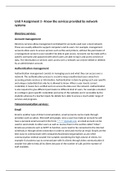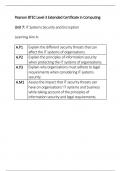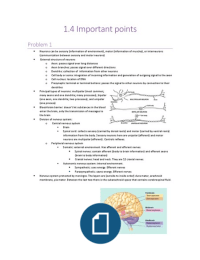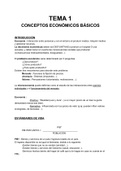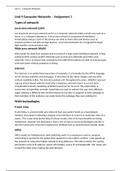Emilia Hawkins
Unit 2: Practical Scientific Procedures and Techniques
A: Undertake titration and colorimetry to determine the concentration of solutions.
Titration
Calibrate equipment
Pipette Burette
Mass of beaker plus 25cm³ water 69.44 69.28
Mass of empty beaker 44.57 44.57
Mass of 25cm³ water 24.87 24.71
Preparation of standard solution Na₂CO₃
The sodium carbonate standard solution was made by measuring out approximately 1.3g of sodium
carbonate to a 250cm³ standard flask; making sure to reweigh the original beaker to get an accurate
mass. Then 100cm³ of distilled water was added to the flask, to dissolve the sodium carbonate, and
make sure that the solution reached the mark on the volumetric flask.
Concentration of standard solution:
250cm³ = 0.25dm³
Moles = mass/Mr
Moles = 1.3g/105.99 = 0.012 mol
Concentration = Moles/Volume
Concentration = 0.012/0.25 = 0.048 mol/dm³
Standardisation of given HCl by titration with primary standard solution Na ₂CO₃
After the standard solution had been prepared, I filled a burette with hydrochloric acid and
transferred 25cm³ of the sodium carbonate standard solution into a conical flask. A few drops of
indicator were then added to the conical flask and the HCl was titrated until the colour changed. I
repeated this process 3 times to increase the accuracy of my results.
Na₂CO₃ + 2HCl > NaCl + CO₂ + H₂O
Initial Volume/cm³ 00.00 00.00 00.00 00.00
Final Volume/cm³ 25.00 25.50 25.10 25.00
Titre/cm³ 25.00 25.50 25.10 25.00
Average = 25.033cm³ / 0.025033dm³
Volume = 5cm³/0.005cm³
Moles (Sodium carbonate) = Concentration (Sodium carbonate) x Volume (Sodium carbonate)
Moles = 0.048 x 0.005 = 0.00024
, Emilia Hawkins
Moles (Hydrochloric acid) = 2 x Moles (Sodium carbonate)
Moles = 2 x 0.00024 = 0.00048mol
Concentration (Hydrochloric acid) = Moles (Hydrochloric acid) / Volume (Hydrochloric acid)
Concentration = 0..025033 = 0.01917 mol/dm³
Titration of NaOH solution of unknown concentration with the standardized HCl
Titration using indicator
When titrating using an indicator, I first needed to calibrate the equipment and then measure 25cm³
of sodium hydroxide of unknown concentration into a 250cm³ conical flask. A few drops of indicator
were added to the conical flask; in this experiment I used phenolphthalein as an indicator. I then
filled a burette with hydrochloric acid and titrated this into the sodium hydroxide solution until the
colour changed. The values were recorded and I repeated the experiment 2 more times to increase
the accuracy of my results.
Titration using pH meter
When titrating using a pH meter, I needed to first calibrate the pipette I was using, and then transfer
25cm³ of sodium hydroxide solution into a small beaker. The pH meter was then calibrated using the
buffer solutions that was provided, and then it was placed into the beaker containing the sodium
hydroxide solution. I filled a burette with hydrochloric acid and this was added to the beaker in 1cm³
portions until the burette was empty. The pH levels were measured every time hydrochloric acid was
added and the results were recorded. I then plotted a graph of change in pH divided by change in
volume over volume HCl added and pH over volume added.
Results
Indicator
NaOH + HCl > NaCl + H₂O
Initial Volume/cm³ 00.00 00.00 00.00
Final Volume/cm³ 25.30 25.50 25.30
Titre/cm³ 25.30 25.50 25.30
Average = 25.367cm³ / 0.025367 dm³
Sodium hydroxide = 25cm³ , 0.1mol/dm³
Moles (Sodium hydroxide) = Concentration (Sodium hydroxide) x Volume (Sodium hydroxide)
Moles = 0.1 x 0.025 = 0.0025mol
Concentration (Hydrochloric acid) = Moles (Hydrochloric acid) / Volume (Hydrochloric acid)
Concentration = 0..025367 = 0.9855 mol/dm³
Unit 2: Practical Scientific Procedures and Techniques
A: Undertake titration and colorimetry to determine the concentration of solutions.
Titration
Calibrate equipment
Pipette Burette
Mass of beaker plus 25cm³ water 69.44 69.28
Mass of empty beaker 44.57 44.57
Mass of 25cm³ water 24.87 24.71
Preparation of standard solution Na₂CO₃
The sodium carbonate standard solution was made by measuring out approximately 1.3g of sodium
carbonate to a 250cm³ standard flask; making sure to reweigh the original beaker to get an accurate
mass. Then 100cm³ of distilled water was added to the flask, to dissolve the sodium carbonate, and
make sure that the solution reached the mark on the volumetric flask.
Concentration of standard solution:
250cm³ = 0.25dm³
Moles = mass/Mr
Moles = 1.3g/105.99 = 0.012 mol
Concentration = Moles/Volume
Concentration = 0.012/0.25 = 0.048 mol/dm³
Standardisation of given HCl by titration with primary standard solution Na ₂CO₃
After the standard solution had been prepared, I filled a burette with hydrochloric acid and
transferred 25cm³ of the sodium carbonate standard solution into a conical flask. A few drops of
indicator were then added to the conical flask and the HCl was titrated until the colour changed. I
repeated this process 3 times to increase the accuracy of my results.
Na₂CO₃ + 2HCl > NaCl + CO₂ + H₂O
Initial Volume/cm³ 00.00 00.00 00.00 00.00
Final Volume/cm³ 25.00 25.50 25.10 25.00
Titre/cm³ 25.00 25.50 25.10 25.00
Average = 25.033cm³ / 0.025033dm³
Volume = 5cm³/0.005cm³
Moles (Sodium carbonate) = Concentration (Sodium carbonate) x Volume (Sodium carbonate)
Moles = 0.048 x 0.005 = 0.00024
, Emilia Hawkins
Moles (Hydrochloric acid) = 2 x Moles (Sodium carbonate)
Moles = 2 x 0.00024 = 0.00048mol
Concentration (Hydrochloric acid) = Moles (Hydrochloric acid) / Volume (Hydrochloric acid)
Concentration = 0..025033 = 0.01917 mol/dm³
Titration of NaOH solution of unknown concentration with the standardized HCl
Titration using indicator
When titrating using an indicator, I first needed to calibrate the equipment and then measure 25cm³
of sodium hydroxide of unknown concentration into a 250cm³ conical flask. A few drops of indicator
were added to the conical flask; in this experiment I used phenolphthalein as an indicator. I then
filled a burette with hydrochloric acid and titrated this into the sodium hydroxide solution until the
colour changed. The values were recorded and I repeated the experiment 2 more times to increase
the accuracy of my results.
Titration using pH meter
When titrating using a pH meter, I needed to first calibrate the pipette I was using, and then transfer
25cm³ of sodium hydroxide solution into a small beaker. The pH meter was then calibrated using the
buffer solutions that was provided, and then it was placed into the beaker containing the sodium
hydroxide solution. I filled a burette with hydrochloric acid and this was added to the beaker in 1cm³
portions until the burette was empty. The pH levels were measured every time hydrochloric acid was
added and the results were recorded. I then plotted a graph of change in pH divided by change in
volume over volume HCl added and pH over volume added.
Results
Indicator
NaOH + HCl > NaCl + H₂O
Initial Volume/cm³ 00.00 00.00 00.00
Final Volume/cm³ 25.30 25.50 25.30
Titre/cm³ 25.30 25.50 25.30
Average = 25.367cm³ / 0.025367 dm³
Sodium hydroxide = 25cm³ , 0.1mol/dm³
Moles (Sodium hydroxide) = Concentration (Sodium hydroxide) x Volume (Sodium hydroxide)
Moles = 0.1 x 0.025 = 0.0025mol
Concentration (Hydrochloric acid) = Moles (Hydrochloric acid) / Volume (Hydrochloric acid)
Concentration = 0..025367 = 0.9855 mol/dm³

